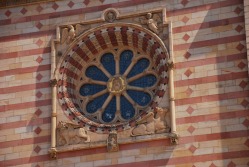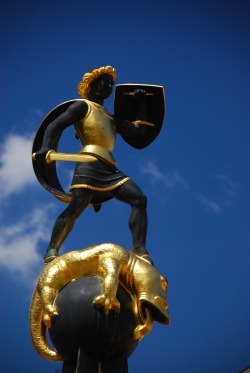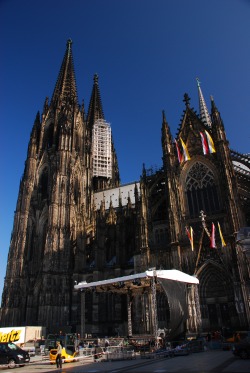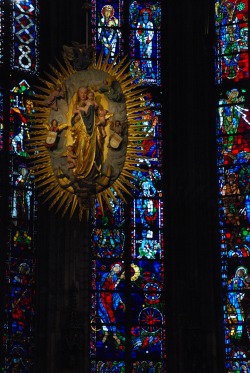I like to think of myself as an informed person: I read news websites (sometimes compulsively), and I pretty generally have a good understanding of current events and political happenings. Imagine my shock when I found out (today) that the Germans had reelected their current president, Horst Köhler, over the weekend. Ironically, I found out from BBC - the German news sites Der Spiegel and Frankfurter Allgemeine Zeitung only covered the election results on Sunday, the day after the election. I felt bad, but after talking to my colleagues, realized that I was far from being alone - the German presidential election isn't quite the same to-do that we have in the US.
So why does no one seem to care about the German President? For starters, it's largely a ceremonial role - the President is expected to be above party politics, and while he can appoint judges or even refuse to sign a law (not quite the same as a veto), the German Bundesrat (House of Representatives) can reverse any decision that he makes. Instead of serving as a political figure, he is more often seen as the conscious of Germany and is expected to provide moral guidance - sort of like an elected constitutional monarch. The Germans have also learned the dangers of charismatic leaders quite well, and so it is practically impossible for the German President to ever assume any national power. The benefits of being the President of Germany are very nice - his residence is a former Prussian palace in Berlin, and he gets a yearly salary of over 200,000 Euros, even after leaving office.
Electing the president is even more complicated than our electoral college. Each member of Congress gets one vote, and each state sends an equal number of delegates who are also given the right to vote. While these delegates are supposed to be political figures or respected community members, they also often include actors and sports stars (not even joking). They vote by secret ballot (although just like in the states this vote is almost always along party lines), and the winner serves a 5-year term. This year's election was apparently somewhat tense - the current president belonged to the CDU/CSU (center-right), but the SPD (center-left) and the Left (strongly socialists) allied in a thankfully unsuccessful attempt to replace him.
If all that was a bit too much information, you're not alone - of the ten or so Germans I've talked to about the election, only three of them admitted to knowing that the election happened, and no-one really wanted to discuss the results - apathy being the main reason. However, you shouldn't take this election as a sign that Germans don't pay attention to politics - the general elections in September are a huge topic, with all four major parties fighting for as large of a share as they can get.
0 Comments
 Germany is full of surprises. Even after having lived here for a full eight months, I'm constantly stumbling across new aspects of German history and corners that if I had less time I would have skipped. Speyer is a great example of this phenomenon - before coming to Germany I'd never heard of it (as a sleepy town of 50,000 on the Upper Rhine, i.e., not Bavaria, it's not exactly what most people have in mind when they think of Germany) - and this relative obscurity is a huge bonus. The town's shining grace is its cathedral, which was built in 1061 by the Salian Emperors, has been a UNESCO World Heritage Site since 1981, making it the second such site in all of Germany. Interestingly, when it was built the cathedral (now recognized as a "minor basilica", whatever that means) was the largest structure in the world, and it remains the largest Romanesque building in the world. Of course, the cathedral is only a reminder of the power that once called Speyer home - the famous "Pilgrimage to Canossa" started in Speyer, and German kings from three seperate dynasties are laid to rest in the cathedral's crypt (also the largest in the world). Indeed, it was this concentration of power along the Rhine, especially in the three "Imperial Cities" of Worms, Mainz, and Speyer meant that for most of the Medieval Period, this part of the Rhineland was Germany - the dynasties came from here and their influence defined the Holy Roman Empire until the Hohenzollerns consolidated power and moved the HRE further to the East, in what is now Bavaria - which had the unintended consequence of linking Germany with beer (Bavarian) instead of wine (Rhenish). Even the architectural style had started to change when the power shifted, with the new dynasties favoring the fashionable Gothic style over the by then old-fashioned Romanesque. Given all of these factors, it's not really surprising that Speyer and the rest of this section of the Rhine somehow feel different - and it's a part of Germany that deserves more attention.  All the history in the world can't compensate for an unpleasant city - and Speyer manages to come through with flying colors in this regard too. For a city with a UNESCO site, we had the city (and the cathedral) pretty much to ourselves. It was a world away from the Vatican, where we were packed into ever-smaller rooms with ever-increasing numbers of people. The only traffic jam that we hit was a German tour group coming into the crypt just as we were leaving - the rest of the time we were free to wander. As soon as we left the cathedral and the main street, the city emptied out. There was a giant park behind the cathedral streching all the way to the Rhine with parts of the old city wall in between, and after crossing the former moat we were alone in the residential area, complete with a giant fountain of a fish spitting water.
After all of this sightseeing, it was time for a break - and it just so happens that Speyer has one of the best beer gardens in Germany, featuring freshly brewed beer, cheap food, and a location right by the cathedral. We stayed here for a bit, just soaking up the atmosphere. I should note that German Biergarten are not what Americans think of - here they are a family affair, complete with playgrounds and fountains so that the kids don't get too bored. From here it was back to walk around the city for a bit, stopping to get a pretzel from one of the city's many stands (trivia fact for the day: the pretzel was supposedly invented in Speyer, and they are quite proud of this fact) before investigating the newer churches - including a neo-gothic church built to commemorate the reformation. It was like the Freiburg cathedral meets Cologne on a much smaller scale - but with three times the stained glass. With any luck, I'll get a chance to go back to Speyer - it also has a world-class technical museum with a collection including a 747, the largest propellor-driven plane in the world, a U-Boat, and - you guessed it - a Russian space shuttle. In short, Speyer is a lot packed into a small package, and since it's still relatively unknown it makes for a very pleasent visit - and it's a perfect example of Disclaimer: it was more of a walk, but that title didn't sound nearly as catchy. My attempt to run 100km in 24 hours is rapidly approaching - as of today, I only have 13 days until it begins. More information can be found here). Although I've been running at least three times a week, only going 4-5 km at a time isn't really the best practice in the world for trying to run/walk 100km in one stretch. To see if we even had a chance, Erica and I did a test walk this Saturday. Our goal was the small town of Nierstein, one of the many wine villages along the Rhine, which had the advantage of being only 18km south of Mainz. With high spirits, we loaded up the backpack with water and sandwiches and headed down the nice trail, keeping the Rhine in sight for most of the way. I'm now officially a stereotype - I'm teaching English abroad. While I never thought that I'd actually be in this position, I'm enjoying teaching much more than I thought, although it's more work than I ever expected. Around January of last year I wanted to get more involved in the community, so I went down to the language center at the University of Marburg and asked if I could help teach an English class - I thought that my skills as a native speaker would help German students get more practice as well as provide me with a fun activity. To my surprise, they asked me to send in a CV - which I thought was a bit much for what I wanted to do - and after I sent it in, they offered me a position teaching two courses: Academic Writing in the Natural Sciences and Intensive English for Human Biologists (basically biomedical research as an undergraduate degree).  At first glance, Cologne and Aachen could hardly be more different. One is a thriving metropolis renowned for its nightlife and breweries, while the other is a small city tucked up against the Dutch and Belgian borders whose primary visitors are high school students from across the region on a historical field trip. But if you take the time to dig just a bit deeper, major similarities start to jump out at you. By the 1st century CE the Romans had established major settlements in both towns, the remains of which can still be seen today. Both towns are known mostly for their impressive cathedrals - the cathedral at Aachen is the best example of Carolingian architecture in the world, and the first major cathedral built on German soil, while the cathedral in Cologne is the best example of late Gothic/neo-Gothic architecture and the last major cathedral built on German soil (the Prussians had to levy a nation-wide tax to complete construction in 1880 after funds dried up back in the 14th Century). Both have played an important role in German history - when Charlemagne ruled Europe, Aachen was his capital, and until the discovery of the New World, Cologne was a major trade center and an important city for intellectual development and book printing. I visited both cities over the weekend with my parents (after Freiburg they went to Berlin and I went back to Marburg to work for a few days) and it was a very nice weekend. Cologne is not what I had expected - it's much more of a modern city and it's formerly medieval downtown doesn't really have a unique "feel" to it (except it's the only city I've seen where every bakery sells two jelly donuts for 1 Euro on all the street corners), but this is probably due to the fact that Allied bombing reduced the city to rubble (except for the Cathedral, which was as a navigation aid and therefore too valuable to bomb). The city was so badly damaged that Konrad Adenauer propsed rebuilding the city on the opposite side of the river so that the rubble wouldn't interfere with the reconstruction! Consequently, there's not a lot of traditional, toursity "sights" apart from the main cathedral, some Roman ruins, and a few Romanesque churches. The cathedral itself is impresive mostly as a funtion of its size - right after you step inside it's hard to do anything but just gape. To be fair, there are some amazing works of art, especially the altar of the Three Magi (where the have the bones of the Three Kings), the Geru Crucifix, windows which would cover three football fields, and a 9th Century mosaic, but the interior was surprisingly plain. Most of the highlights are found in the choir, which was the only part of the church which was completed in the middle ages - the rest of the cathedral is neo-Gothic from the 1820's to the 1880's and served as a symbol of German nationalism. Climbing the tower was a very cool experience - before the Eiffel tower was built, these towers were the tallest building in the world and the views of the masonry were amazing.  Cologne's other claim to fame (we'll ignore Karneval for now) is its beer - the Kölsch brewed there is a very light beer served in small glasses, but the waiters keep bringing it to you unless you cover your glass with a coaster. To prevent beer thievery they make tally marks on your coaster, and the whole atmosphere is pretty convival - it's like an odd mixture between a Munich beer hall and a British pub. There are tons of breweries throughout the city, as Cologne is the only city allowed to produce Kölsch, and they all have their own history and traditions. Certainly a must-do if you find yourself in town.
After one full day in Cologne, which is enough to see most things we were off to Aachen for a day trip. We spent the early morning trying to dodge groups of French high school students (just as obnoxious as it sounds) but we timed our tours to avoid them almost perfectly. The Cathedral Museum contains a mind-blowing collection of reliquaries (if you believe that sort of thing, which I don't recommend, you can find Mary's belt and the rope that scourged Jesus) and some of Charlemagne's bones. The cathedral easily steals the show - it's essentially an octagon built in 800 with a gothic choir attached to it. The Carolingian octagon forms the centerpiece of the cathedral, and its design is striking - it feels much more like a tower than a cathedral. Mosaics cover the walls and ceilings, and when you combine these with the soaring arches and 12th Century chandelier made from gilded bronze the effect is amazing - even after reaching the point of "European Cathedral Saturation" I was still wandering around a bit awe-struck. I'm glad that I got to see both of these cathedrals on the same trip - if I had more time between cities I would never have been able to make any of the connections between the two cities. Despite the typical German weather, it turned out to be a great trip and I'm glad that I got to share it with my parents. For more pictures, see the Aachen, Freiburg, and Cologne Gallery.  Freiburg is one of my favorite German cities (the other contenders being Munich, and, of course, Marburg). It's located right in the middle of the black forest, has a vibrant downtown, lots of students, good food, Biergartens, and one of the most impressive cathedrals in the world (which would be more impressive if it weren't being constantly renovated. From a statistical standpoint, it's Germany's sunniest city, and it is also the most desirable place to live amongst the Germans themselves. Ironically, it's not a very typically German town - it lies close to the French and Swiss border, and since it belonged to the Austrian Empire until well into the 19th Century it maintains a very international character which is somewhat unique for a German city. Support for the EU is high - the EU flag flew proudly from the town hall and there were many information booths and various politicking things in anticipation of the upcoming European elections. For our second (and sadly last) day in Freiburg, we walked over to the Farmer's Market, which takes place around the cathedral. The market is an odd mix of local farmers, gourmet food (how many German farmers make sheep's cheese soaked in oil and herbs?), and carved wooden decorations (most of them fairly useless). From here we went on to grab some supplies for lunch (Bauernbrot, some of the amazing Reisling produced in the nearby vineyards, and local cheese) before heading to the Black Forest.  As Freiburg is right in the middle of the Black Forest, we decided that we should go for a hike there, and so we took a tram up to the top of Schauinsland, a combination hiking trail/tourist attraction/mining museum after lunch. The views from the top of the mountain (not quite the highest in the Black Forest - that honor belongs to the Feldberg - but at 1200 meters pretty far up there) streched all the way to Mont Blanc and the rest of The Alps, making it one of the few places where you can look into two other countries (border crossings excluded). We originally planned to tour the old silver mining complex, but after looking through the description realized that we had not brought the proper hiking shoes (and since we all only had one pair of shoes, destroying them in mud was not really an option). Somewhat dissapointed, we continued on to the lookout tower, where the views of The Alps were good, but not quite stunning (if we squinted, we saw them, otherwise lots of haze). Copper is one of those elements that we don't pay much attention to, unless we're thinking about pennies. But it's required for the production of melanin (which makes us tan), hormones (which influence our behavior), connective tissue (which holds us together), and it plays a vital role in cellular respiration and iron homeostasis (which keep us alive). In addition to all of these vital functions, copper serves as the active site of over 30 other metalloenzymes (it helps catalyze chemical reactions in the body). Copper catalyzes similar reactions in other aerobic species, including bacteria. Although it's such a necessary part of our biochemistry, too much copper can be toxic, so its cellular levels need to be well-regulated - and this balance is the focus of Dr. Marc Solioz' research at the University of Bern.  The border crossing is almost imperceptible now. There are no checkpoints, no guards, and no barbed wire. But you notice that things are somehow different here in the former German Democratic Republic, even 20 years after the German reunification. It's not a change that you can put your finger on - it might be the juxtaposition of the shining restorations with the crumbling factory buildings, or it might be the broken windows that suddenly seem to be everywhere. This visit marks my first trip to Eastern Germany - downtown Berlin hardly counts - and my first time on the German coast. We came here on a whim, and it proved to be a strange mix of the comfortably familiar and the decidedly foreign. Not bad for a six-hour train ride.  The fact that the Soviets occupied Wismar for so long is apparent on every street. In Western Germany, the war damage was quickly repaired, factories were rebuilt, and these rebuilding measures were encouraged and supported by the occupying powers. In the GDR, the philosophy of the occupying forces ran more along the lines of "take what you can and destroy the rest." When cathedrals all over Western Germany were being rebuilt, the Soviets bombed what was left of the ruins of the church of St. Marien - reconstruction was too expensive and the church didn't get on well with the government.  As much as we liked the town, it was just a bit small to be able to spend two full days there, so on our second day we rented bikes from the hostel and went off into the countryside. Like most German towns, the agriculture/national preserves/rural areas begin right where the town ends. Wismar is especially blessed in this regard, as a wide peninsula stretches up from the harbor to the Isle of Poel, providing great views across a fairly flat landscape. The bike path follows this peninsula north, where it passes through fields and pastures, and the yellow of the rapeseed flowers set off the green fields and blue sea nicely. On our way to the island we passed by old thatched roof houses and a stable, but the past was present even here: a concrete ship used by Dornier as a practice bombing target still stands wrecked on the shore. |
 RSS Feed
RSS Feed